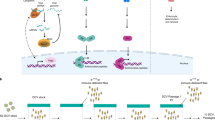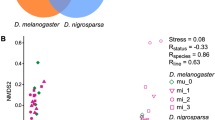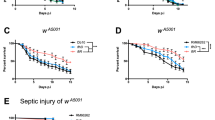Abstract
Conservation of host signaling pathways and tissue physiology between Drosophila melanogaster and mammals allows for the modeling of human host–pathogen interactions in Drosophila. Here we present the use of genetically tractable Drosophila models of bacterial pathogenesis to study infection with the human opportunistic pathogen Pseudomonas aeruginosa. We describe and compare two protocols commonly used to infect Drosophila with P. aeruginosa: needle-pricking and injector-pumping. Each model has relevance for examining host components and bacterial factors in host defense and virulence. Fly survival and bacterial proliferation within host flies can be assessed as a measure of host susceptibility and pathogen virulence potential. The profiles of host responses toward P. aeruginosa virulent and non-virulent strains can be determined, enabling the identification of interaction-specific genes that could potentially favor or limit the initiation and progression of infection. Both of the protocols presented herein may be adapted for the inoculation and study of other microbial pathogens. P. aeruginosa cell preparation requires 24 h, fly inoculation 1 h, and fly survival and bacterial proliferation 1–4 d.
This is a preview of subscription content, access via your institution
Access options
Subscribe to this journal
Receive 12 print issues and online access
$259.00 per year
only $21.58 per issue
Buy this article
- Purchase on Springer Link
- Instant access to full article PDF
Prices may be subject to local taxes which are calculated during checkout


Similar content being viewed by others
References
Lyczak, J.B., Cannon, C.L. & Pier, G.B. Establishment of Pseudomonas aeruginosa infection: lessons from a versatile opportunist. Microbes Infect. 2, 1051–1060 (2000).
Jander, G., Rahme, L.G. & Ausubel, F.M. Positive correlation between virulence of Pseudomonas aeruginosa mutants in mice and insects. J. Bacteriol. 182, 3843–3845 (2000).
Lau, G.W. et al. The Drosophila melanogaster toll pathway participates in resistance to infection by the Gram-negative human pathogen Pseudomonas aeruginosa . Infect. Immun. 71, 4059–4066 (2003).
Mahajan-Miklos, S., Tan, M.W., Rahme, L.G. & Ausubel, F.M. Molecular mechanisms of bacterial virulence elucidated using a Pseudomonas aeruginosa-Caenorhabditis elegans pathogenesis model. Cell 96, 47–56 (1999).
Rahme, L.G. et al. Common virulence factors for bacterial pathogenicity in plants and animals. Science 268, 1899–1902 (1995).
Baldini, R.L., Lau, G.W. & Rahme, L.G. Use of plant and insect hosts to model bacterial pathogenesis. Methods Enzymol. 358, 3–13 (2002).
Rahme, L.G. et al. Use of model plant hosts to identify Pseudomonas aeruginosa virulence factors. Proc. Natl. Acad. Sci. USA 94, 13245–13250 (1997).
Lutter, E.I., Faria, M.M., Rabin, H.R. & Storey, D.G. Pseudomonas aeruginosa cystic fibrosis isolates from individual patients demonstrate a range of lethality in two Drosophila melanogaster infection models. Infect. Immun. 76, 1877–1888 (2008).
Ferrandon, D., Imler, J.L., Hetru, C. & Hoffmann, J.A. The Drosophila systemic immune response: sensing and signalling during bacterial and fungal infections. Nat. Rev. Immunol. 7, 862–874 (2007).
Basset, A., Tzou, P., Lemaitre, B. & Boccard, F. A single gene that promotes interaction of a phytopathogenic bacterium with its insect vector, Drosophila melanogaster . EMBO Rep. 4, 205–209 (2003).
Nehme, N.T. et al. A model of bacterial intestinal infections in Drosophila melanogaster . PLoS Pathog. 3, e173 (2007).
Apidianakis, Y. et al. Involvement of skeletal muscle gene regulatory network in susceptibility to wound infection following trauma. PLoS ONE 2, e1356 (2007).
Apidianakis, Y. et al. Profiling early infection responses: Pseudomonas aeruginosa eludes host defenses by suppressing antimicrobial peptide gene expression. Proc. Natl. Acad. Sci. USA 102, 2573–2578 (2005).
Boman, H.G., Nilsson, I. & Rasmuson, B. Inducible antibacterial defence system in Drosophila . Nature 237, 232–235 (1972).
Fauvarque, M.O. et al. Role and activation of type III secretion system genes in Pseudomonas aeruginosa-induced Drosophila killing. Microb. Pathog. 32, 287–295 (2002).
Avet-Rochex, A., Bergeret, E., Attree, I., Meister, M. & Fauvarque, M.O. Suppression of Drosophila cellular immunity by directed expression of the ExoS toxin GAP domain of Pseudomonas aeruginosa . Cell Microbiol. 7, 799–810 (2005).
Chugani, S.A. et al. QscR, a modulator of quorum-sensing signal synthesis and virulence in Pseudomonas aeruginosa . Proc. Natl. Acad. Sci. USA 98, 2752–2757 (2001).
Corby-Harris, V., Habel, K.E., Ali, F.G. & Promislow, D.E. Alternative measures of response to Pseudomonas aeruginosa infection in Drosophila melanogaster . J. Evol. Biol. 20, 526–533 (2007).
D'Argenio, D.A., Gallagher, L.A., Berg, C.A. & Manoil, C. Drosophila as a model host for Pseudomonas aeruginosa infection. J. Bacteriol. 183, 1466–1471 (2001).
Kim, S.H., Park, S.Y., Heo, Y.J. & Cho, Y.H. Drosophila melanogaster-based screening for multihost virulence factors of Pseudomonas aeruginosa PA14 and identification of a virulence-attenuating factor, HudA. Infect. Immun. 76, 4152–4162 (2008).
Lemaitre, B., Reichhart, J.M. & Hoffmann, J.A. Drosophila host defense: differential induction of antimicrobial peptide genes after infection by various classes of microorganisms. Proc. Natl. Acad. Sci. USA 94, 14614–14619 (1997).
Schneider, D.S. et al. Drosophila eiger mutants are sensitive to extracellular pathogens. PLoS Pathog. 3, e41 (2007).
Sibley, C.D. et al. Discerning the complexity of community interactions using a Drosophila model of polymicrobial infections. PLoS Pathog. 4, e1000184 (2008).
Vodovar, N. et al. Drosophila host defense after oral infection by an entomopathogenic Pseudomonas species. Proc. Natl. Acad. Sci. USA 102, 11414–11419 (2005).
Vallet-Gely, I., Lemaitre, B. & Boccard, F. Bacterial strategies to overcome insect defences. Nat. Rev. Microbiol. 6, 302–313 (2008).
Apidianakis, Y. et al. Challenge of Drosophila melanogaster with Cryptococcus neoformans and role of the innate immune response. Eukaryot. Cell 3, 413–419 (2004).
Chamilos, G. et al. Drosophila melanogaster as a facile model for large-scale studies of virulence mechanisms and antifungal drug efficacy in Candida species . J. Infect. Dis. 193, 1014–1022 (2006).
Gottar, M. et al. Dual detection of fungal infections in Drosophila via recognition of glucans and sensing of virulence factors. Cell 127, 1425–1437 (2006).
Fritz, J.H., Girardin, S.E. & Philpott, D.J. Innate immune defense through RNA interference. Sci. STKE 2006, pe27 (2006).
Cherry, S. & Perrimon, N. Entry is a rate-limiting step for viral infection in a Drosophila melanogaster model of pathogenesis. Nat. Immunol. 5, 81–87 (2004).
Blow, N.S. et al. Vibrio cholerae infection of Drosophila melanogaster mimics the human disease cholera. PLoS Pathog. 1, e8 (2005).
Cox, C.R. & Gilmore, M.S. Native microbial colonization of Drosophila melanogaster and its use as a model of Enterococcus faecalis pathogenesis. Infect. Immun. 75, 1565–1576 (2007).
Garfinkel, M.D., Sollars, V.E., Lu, X. & Ruden, D.M. Multigenerational selection and detection of altered histone acetylation and methylation patterns: toward a quantitative epigenetics in Drosophila . Methods Mol. Biol. 287, 151–168 (2004).
Tollefsbol, T.O. (ed.) Biological Aging: Methods and Protocols (Springer, New York) 119–120 (2007).
Taylor, K. & Kimbrell, D.A. Host immune response and differential survival of the sexes in Drosophila . Fly (Austin) 1, 197–204 (2007).
Leulier, F. et al. The Drosophila immune system detects bacteria through specific peptidoglycan recognition. Nat. Immunol. 4, 478–484 (2003).
Brandt, S.M. & Schneider, D.S. Bacterial infection of fly ovaries reduces egg production and induces local hemocyte activation. Dev. Comp. Immunol. 31, 1121–1130 (2007).
Kaplan, E. & Meier, P. Nonparametric estimation from incomplete observations. J. Am. Stat. Assoc. 53, 457–481 (1958).
Gosset, W. The probable error of the mean. Biometrika 6, 1–25 (1908).
Ferrandon, D. et al. A drosomycin-GFP reporter transgene reveals a local immune response in Drosophila that is not dependent on the Toll pathway. EMBO J. 17, 1217–1227 (1998).
Reichhart, J.M. et al. Insect immunity: developmental and inducible activity of the Drosophila diptericin promoter. EMBO J. 11, 1469–1477 (1992).
Tzou, P. et al. Tissue-specific inducible expression of antimicrobial peptide genes in Drosophila surface epithelia. Immunity 13, 737–748 (2000).
Lemaitre, B. et al. A recessive mutation, immune deficiency (imd), defines two distinct control pathways in the Drosophila host defense. Proc. Natl. Acad. Sci. USA 92, 9465–9469 (1995).
Boutros, M., Agaisse, H. & Perrimon, N. Sequential activation of signaling pathways during innate immune responses in Drosophila . Dev. Cell 3, 711–722 (2002).
De Gregorio, E., Spellman, P.T., Tzou, P., Rubin, G.M. & Lemaitre, B. The Toll and Imd pathways are the major regulators of the immune response in Drosophila . EMBO J. 21, 2568–2579 (2002).
Deziel, E. et al. The contribution of MvfR to Pseudomonas aeruginosa pathogenesis and quorum sensing circuitry regulation: multiple quorum sensing-regulated genes are modulated without affecting lasRI, rhlRI or the production of N-acyl-L-homoserine lactones. Mol. Microbiol. 55, 998–1014 (2005).
Padfield, K.E. et al. Burn injury causes mitochondrial dysfunction in skeletal muscle. Proc. Natl. Acad. Sci. USA 102, 5368–5373 (2005).
Liberati, N.T. et al. An ordered, nonredundant library of Pseudomonas aeruginosa strain PA14 transposon insertion mutants. Proc. Natl. Acad. Sci. USA 103, 2833–2838 (2006).
Lazzaro, B.P., Flores, H.A., Lorigan, J.G. & Yourth, C.P. Genotype-by-environment interactions and adaptation to local temperature affect immunity and fecundity in Drosophila melanogaster . PLoS Pathog. 4, e1000025 (2008).
Linder, J.E., Owers, K.A. & Promislow, D.E. The effects of temperature on host-pathogen interactions in D. melanogaster: who benefits? J. Insect. Physiol. 54, 297–308 (2008).
Dionne, M.S., Pham, L.N., Shirasu-Hiza, M. & Schneider, D.S. Akt and FOXO dysregulation contribute to infection-induced wasting in Drosophila . Curr. Biol. 16, 1977–1985 (2006).
Tzou, P., Meister, M. & Lemaitre, B. Methods for studying infection and immunity in Drosophila . Methods Microbiol. 31, 507–529 (2002).
Riegler, M., Charlat, S., Stauffer, C. & Mercot, H. Wolbachia transfer from Rhagoletis cerasi to Drosophila simulans: investigating the outcomes of host-symbiont coevolution. Appl. Environ. Microbiol. 70, 273–279 (2004).
Elrod-Erickson, M., Mishra, S. & Schneider, D. Interactions between the cellular and humoral immune responses in Drosophila . Curr. Biol. 10, 781–784 (2000).
Kocks, C. et al. Eater, a transmembrane protein mediating phagocytosis of bacterial pathogens in Drosophila . Cell 123, 335–346 (2005).
Gottar, M. et al. The Drosophila immune response against Gram-negative bacteria is mediated by a peptidoglycan recognition protein. Nature 416, 640–644 (2002).
Buchon, N., Broderick, N.A., Poidevin, M., Pradervand, S. & Lemaitre, B. Drosophila intestinal response to bacterial infection: activation of host defense and stem cell proliferation. Cell Host Microbe 5, 200–211 (2009).
Dionne, M.S., Ghori, N. & Schneider, D.S. Drosophila melanogaster is a genetically tractable model host for Mycobacterium marinum . Infect. Immun. 71, 3540–3550 (2003).
Liehl, P., Blight, M., Vodovar, N., Boccard, F. & Lemaitre, B. Prevalence of local immune response against oral infection in a Drosophila/Pseudomonas infection model. PLoS Pathog. 2, e56 (2006).
Park, S.Y., Heo, Y.J., Kim, K.S. & Cho, Y.H. Drosophila melanogaster is susceptible to Vibrio cholerae infection. Mol. Cells 20, 409–415 (2005).
Leclerc, V. et al. Prophenoloxidase activation is not required for survival to microbial infections in Drosophila . EMBO Rep. 7, 231–235 (2006).
Bischoff, V. et al. Function of the drosophila pattern-recognition receptor PGRP-SD in the detection of Gram-positive bacteria. Nat. Immunol. 5, 1175–1180 (2004).
Takehana, A. et al. Peptidoglycan recognition protein (PGRP)-LE and PGRP-LC act synergistically in Drosophila immunity. EMBO J. 23, 4690–4700 (2004).
Bernal, A. & Kimbrell, D.A. Drosophila Thor participates in host immune defense and connects a translational regulator with innate immunity. Proc. Natl. Acad. Sci. USA 97, 6019–6024 (2000).
Alarco, A.M. et al. Immune-deficient Drosophila melanogaster: a model for the innate immune response to human fungal pathogens. J. Immunol. 172, 5622–5628 (2004).
Lemaitre, B., Nicolas, E., Michaut, L., Reichhart, J.M. & Hoffmann, J.A. The dorsoventral regulatory gene cassette spatzle/Toll/cactus controls the potent antifungal response in Drosophila adults. Cell 86, 973–983 (1996).
Bhabhra, R. et al. Disruption of the Aspergillus fumigatus gene encoding nucleolar protein CgrA impairs thermotolerant growth and reduces virulence. Infect. Immun. 72, 4731–4740 (2004).
Chamilos, G. et al. Drosophila melanogaster as a model host to dissect the immunopathogenesis of zygomycosis. Proc. Natl. Acad. Sci. USA 105, 9367–9372 (2008).
Lamaris, G.A., Chamilos, G., Lewis, R.E. & Kontoyiannis, D.P. Virulence studies of Scedosporium and Fusarium species in Drosophila melanogaster . J. Infect. Dis. 196, 1860–1864 (2007).
Ekengren, S. & Hultmark, D. Drosophila cecropin as an antifungal agent. Insect. Biochem. Mol. Biol. 29, 965–972 (1999).
Kirsanova, R.V., Levitin, M.M., Lekarkina, L.P., Usenko, L.I. & Sharygin, V.I. Drosophila and the entomopathogenic fungus Beauveria bassiana as a model for the study of host and parasite interrelationships. Zh. Obshch. Biol. 36, 251–258 (1975).
Acknowledgements
This work was partially supported by the research grants, Shriners #8892 and R01AI063433. Y.A. was supported by Shriners research fellowship #8508.
Author information
Authors and Affiliations
Contributions
Y.A. and L.G.R. wrote the paper. Y.A. performed the experiments.
Corresponding author
Rights and permissions
About this article
Cite this article
Apidianakis, Y., Rahme, L. Drosophila melanogaster as a model host for studying Pseudomonas aeruginosa infection. Nat Protoc 4, 1285–1294 (2009). https://doi.org/10.1038/nprot.2009.124
Published:
Issue Date:
DOI: https://doi.org/10.1038/nprot.2009.124
This article is cited by
-
HP1a-mediated heterochromatin formation promotes antimicrobial responses against Pseudomonas aeruginosa infection
BMC Biology (2022)
-
Colistin-degrading proteases confer collective resistance to microbial communities during polymicrobial infections
Microbiome (2022)
-
Pseudomonas aeruginosa core metabolism exerts a widespread growth-independent control on virulence
Scientific Reports (2020)
-
Characterization of a bacteriophage with broad host range against strains of Pseudomonas aeruginosa isolated from domestic animals
BMC Microbiology (2019)
-
Whole-organism phenotypic screening for anti-infectives promoting host health
Nature Chemical Biology (2018)
Comments
By submitting a comment you agree to abide by our Terms and Community Guidelines. If you find something abusive or that does not comply with our terms or guidelines please flag it as inappropriate.



